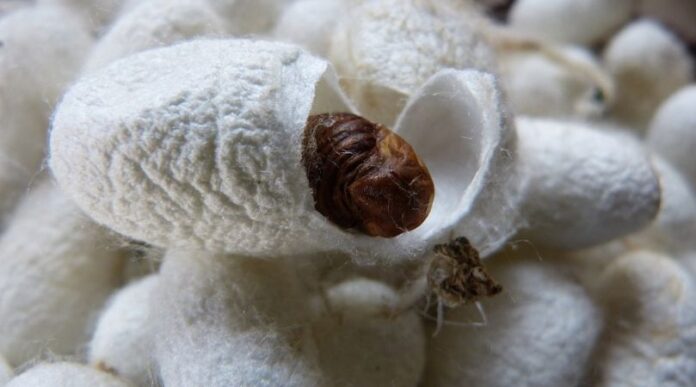By Our Editor
Small silk fabrics are very tough and strong and these are used in clothing, upholstery, umbrellas, hats, lampshades, and strings for musical instruments, etc. Silk fibres are produced by silkworms which feed on leaves of mulberry trees. Silk culture or sericulture is the care of little insects that produce silk threads. It is extremely delicate work and needs great patience throughout entire cycle of silk moth, from egg to cocoon. Sericulture was an important cottage industry practised by people of Meghalaya for many years. The four varieties of raw silk produced by sericulture are mulberry, eri, tasar and muga. Silk has been highly valued for its luxurious qualities for centuries. Mulberry silkworm is most important for all the four types and China, India, Japan, and Italy are leading silk producers besides many other countries. India continues to be second largest producer of silk in the world next to China. Italy has been raising silkworms since 12th century and is the most important silk producer in the Western world.
Due to development of synthetic fibres in last century, demand and production of natural silk declined considerably. But because of intensive research and improved technology, the industry has gained much and continues to further grow. Central Silk Board (CSB) established in 1948 has been entrusted with the task of developing silk industry and help in marketing and export. CSB provides research and training support to institutes located in different parts of India. Institutes at Mysuru (Karnataka), Berhampore (West Bengal) and Pampore (Jammu & Kashmir) deal with mulberry sericulture, that at Ranchi (Jharkhand) specialises in tasar culture, and the last one at Jorhat (Assam) for muga and eri culture. These different institutes have rendered valuable services to silk farmers who in turn have given employment to quite a good number of people in their respective regions.
On August 6, a Design, Innovation & Resource Centre (DIRC) was inaugurated at Umden-Diwon, the first Eri Silk village, Ri Bhoi district with an aim to focus on Ahimsa silk, organic dyes, women – centric and global presence aspects by Department of Textiles for the 8th National Handloom Day. Chief Guest, Minister of Textiles Banteidor Lyngdoh hopes that local weavers would benefit in showcasing indigenous designs. Local MLA of Nongpoh, Mayralborn Syiem expressed gratitude to the department which will boost silk production in the state and expects that soon there will be export outside the state which is challenge to designers and weavers. The Indian Silk Promotion Council (ISEPC), Mumbai undertakes activities relating to promotion of exports of natural silk goods from India and acts as registering authority for silk exporters. Council also produces and disseminates information to its members about market developments in the world, changes in trade policies, etc through its monthly magazine ‘Silk Net’. Silk sample catalogues containing various samples available in the state/centre and in India as well brought out by Council are available to potential buyers, importing textile agents and Indian Missions abroad.


